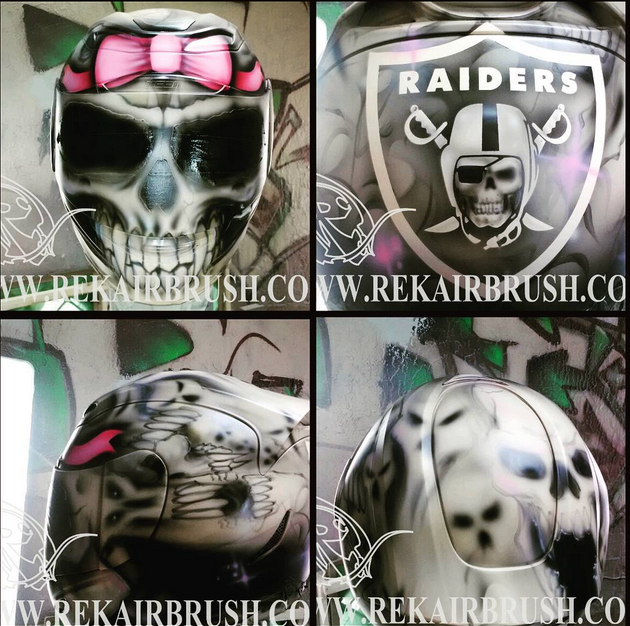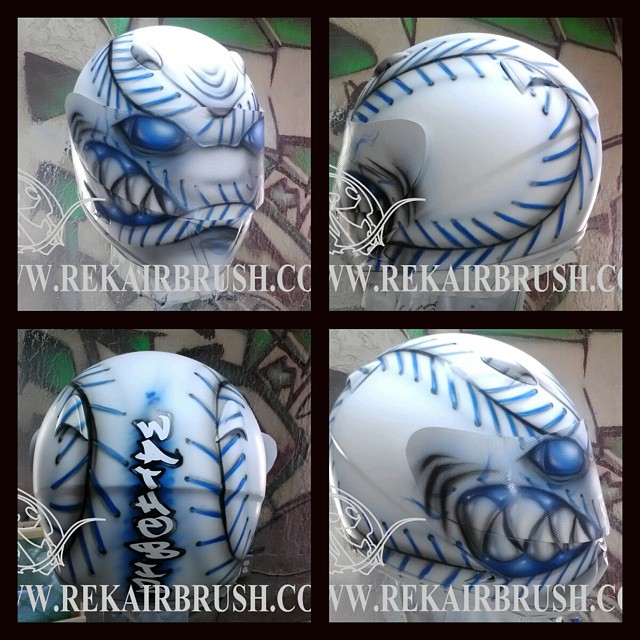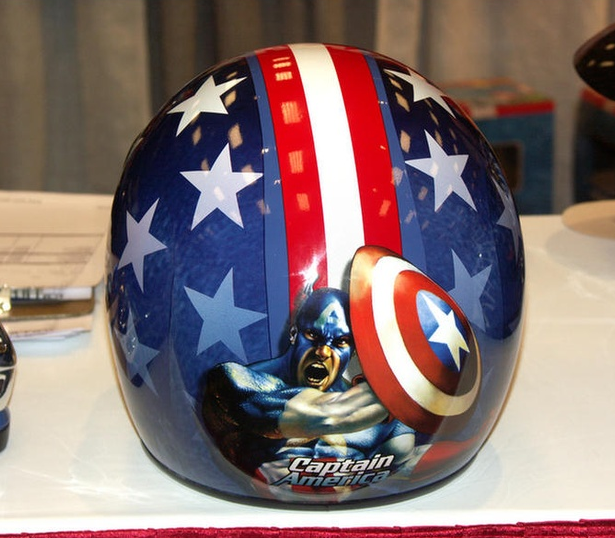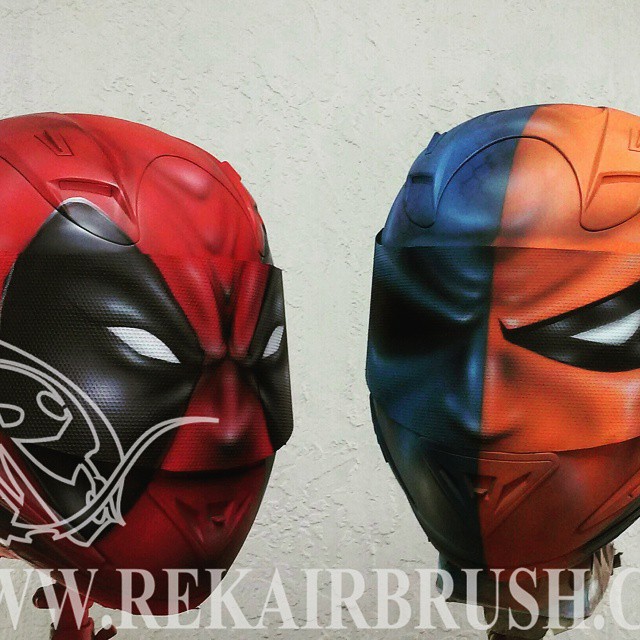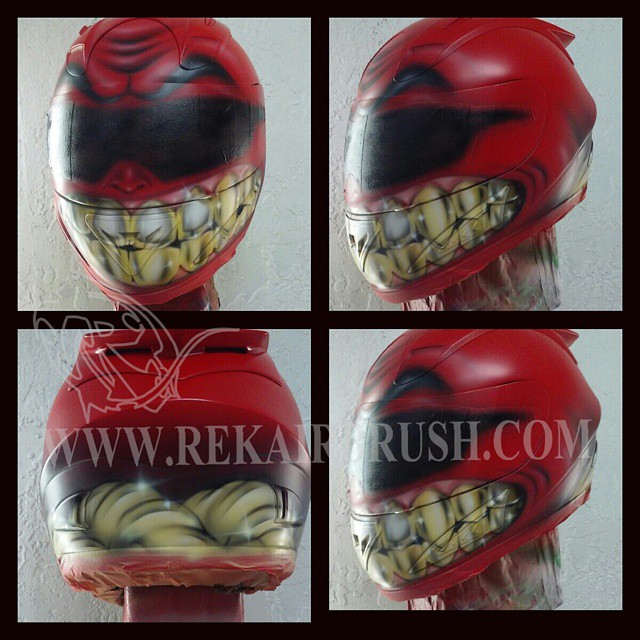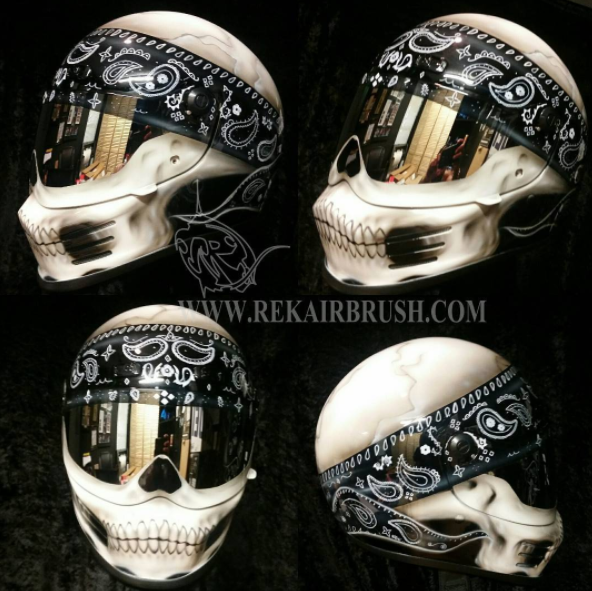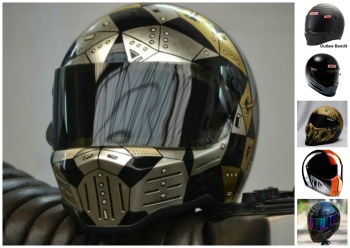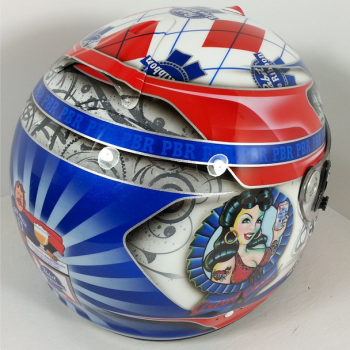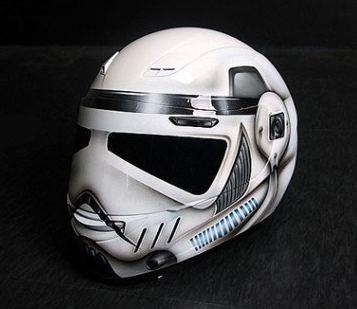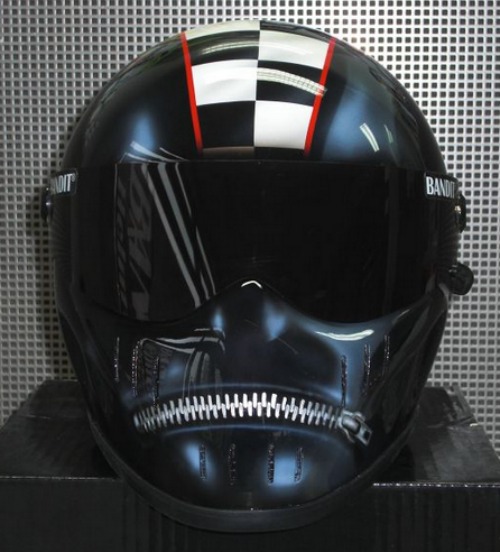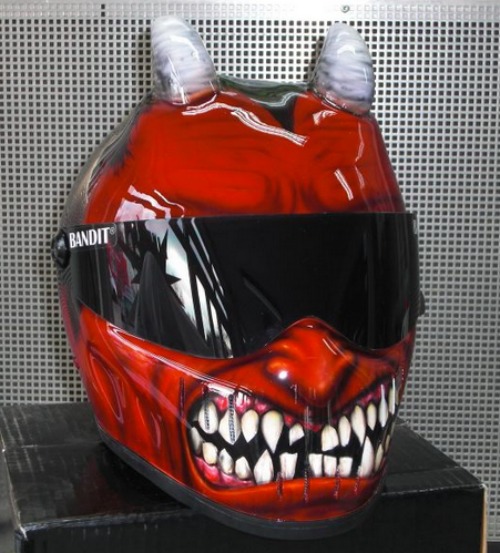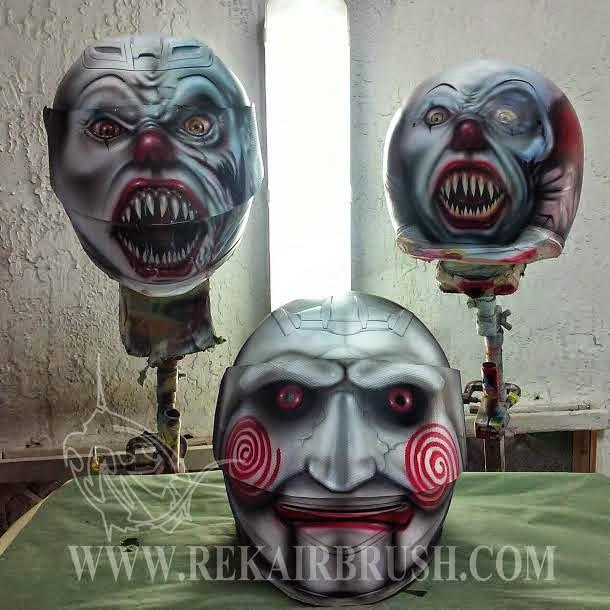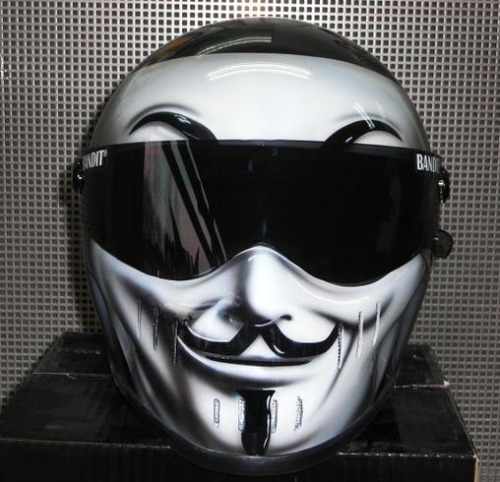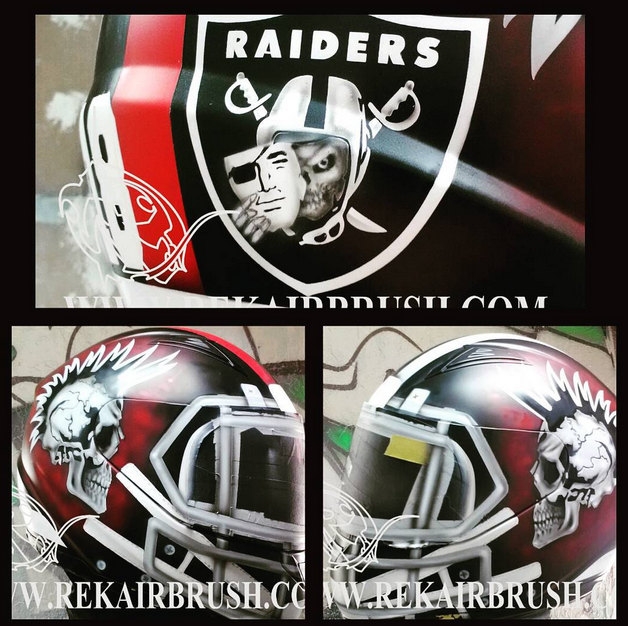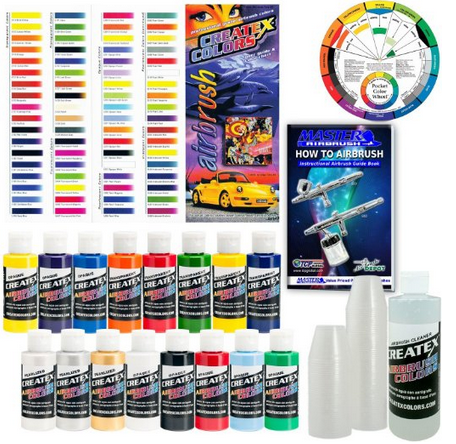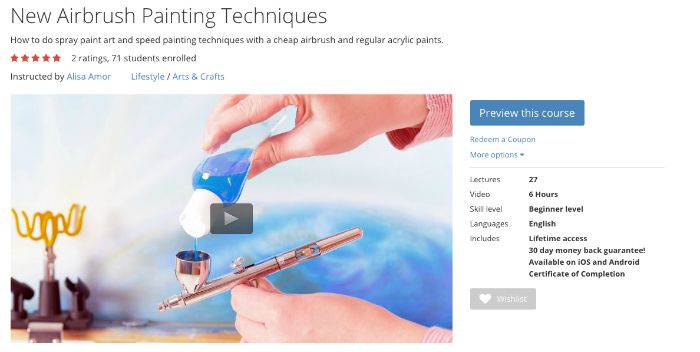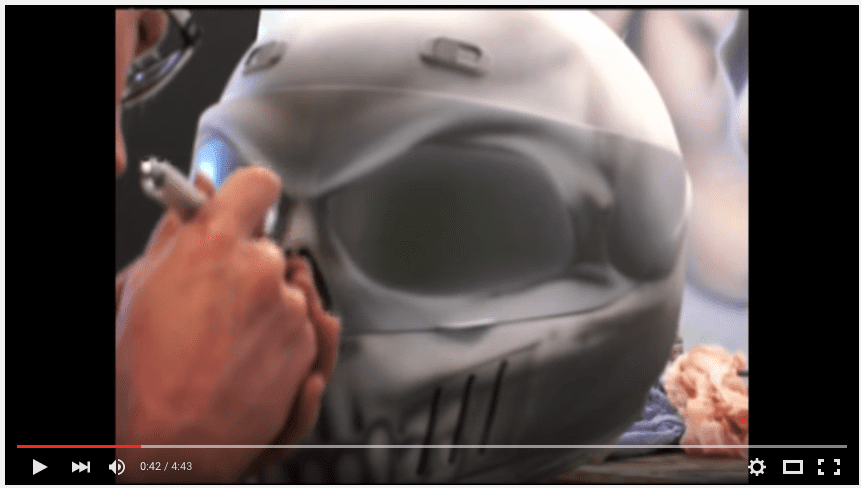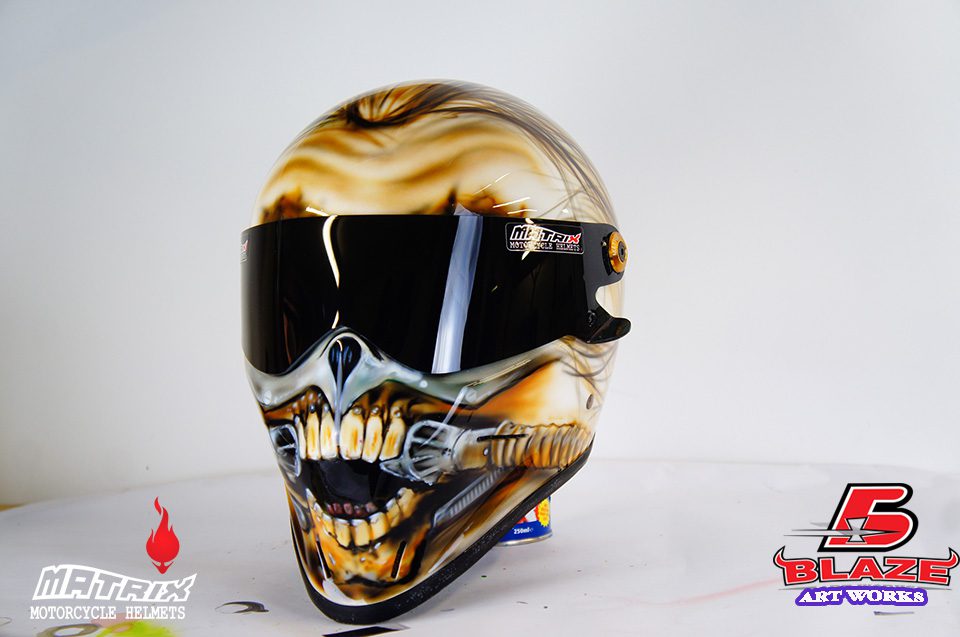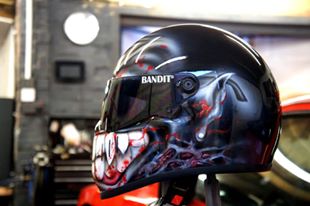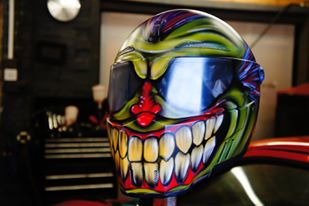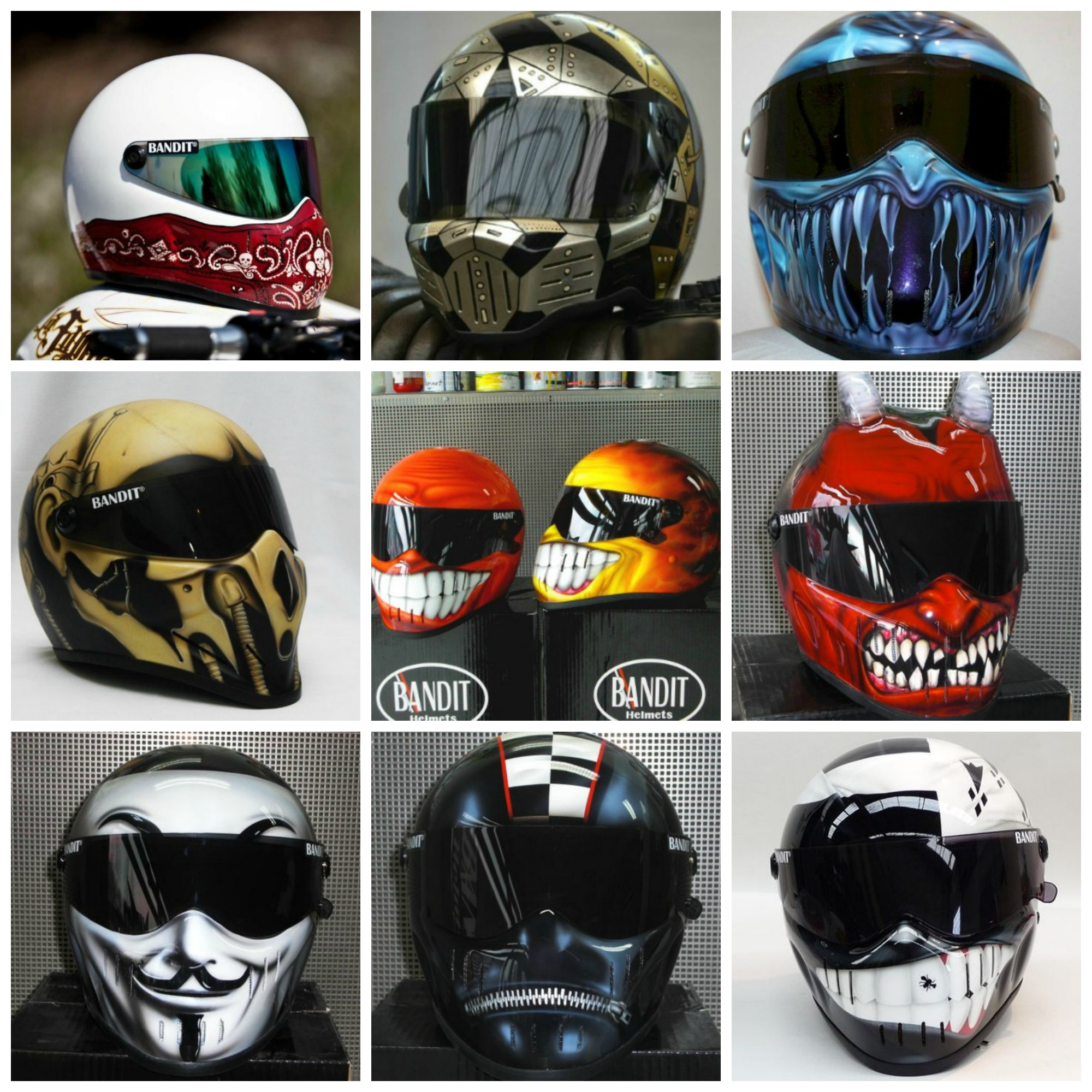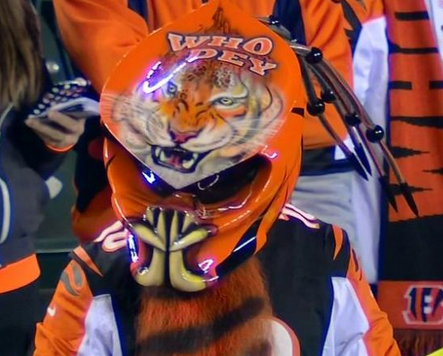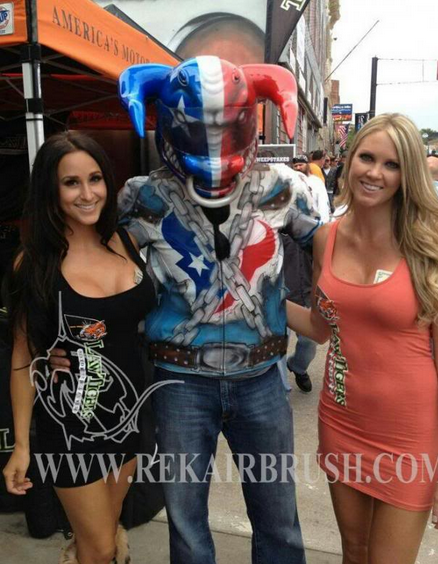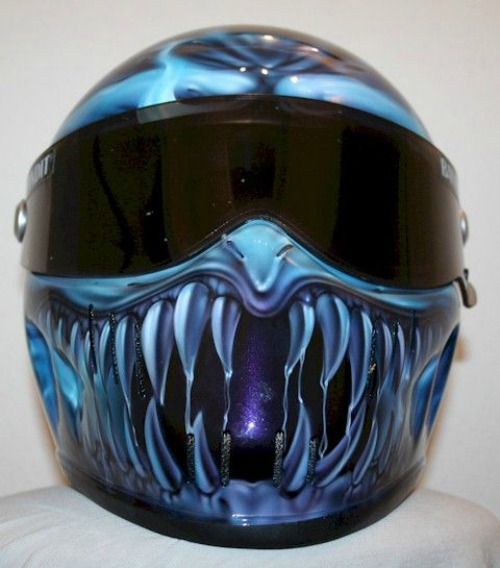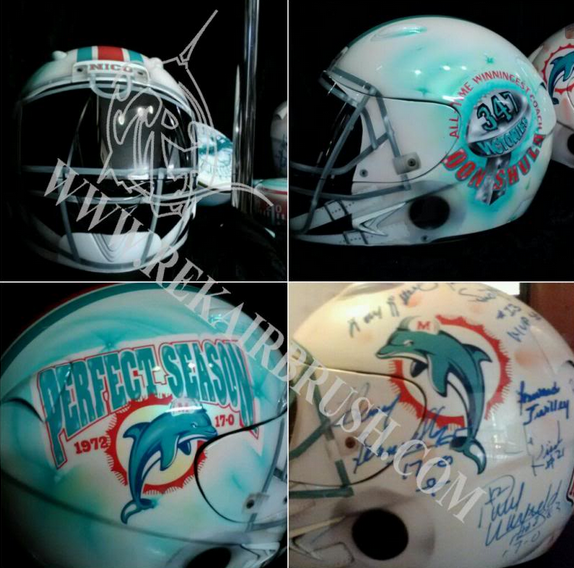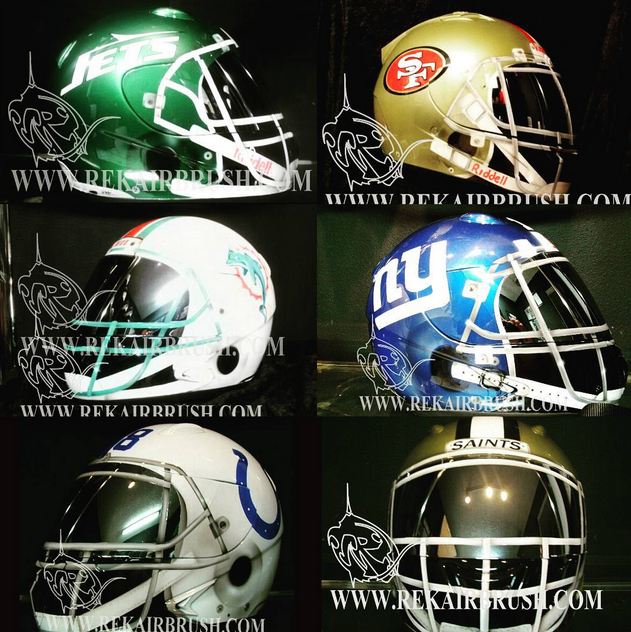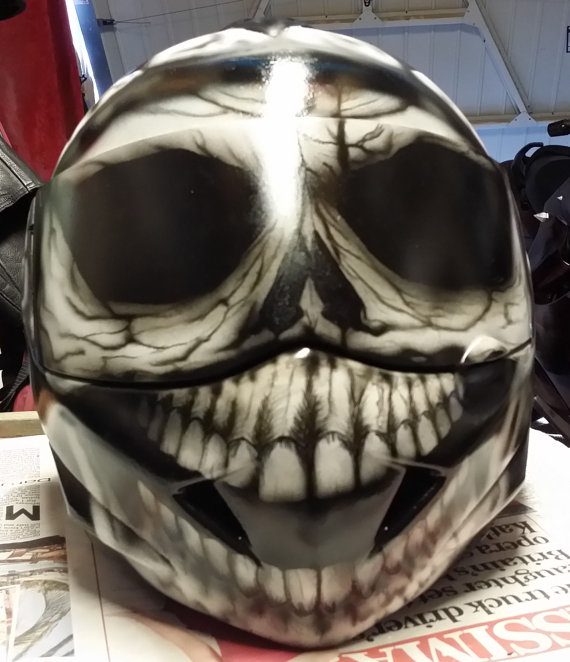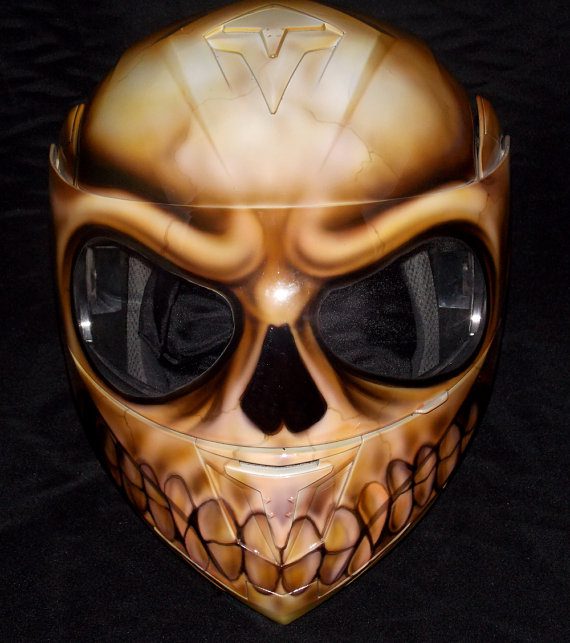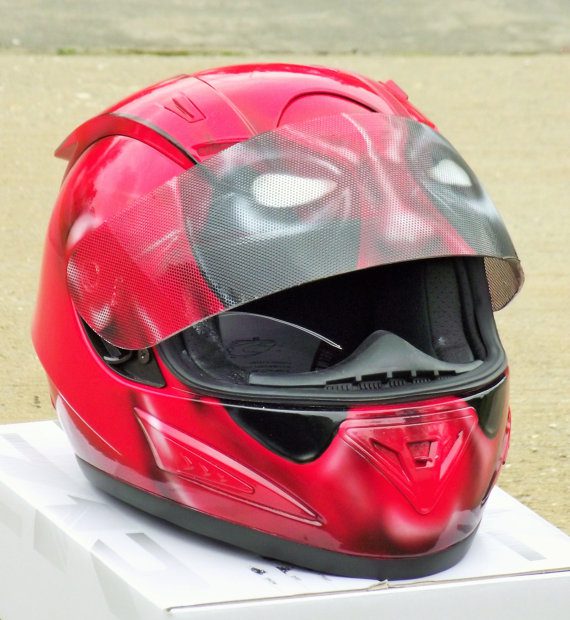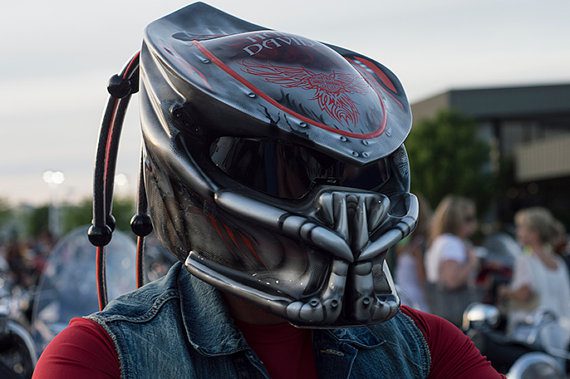Helmets that have been painted with an air gun or air brush are referred to as Airbrushed Motorcycle Helmets. Here are a few popular designs including NFL and College Football Helmets, Bandit Helmets, Pinup Helmets, Beer Helmets, and one from the Coolest Helmets of 2014.
See more designs at Rekairbrush and Airgraffix
[expand title=”History of the Airbrush Art” elwraptag=”div” elwrapclass=”wrap-col”] It’s always important to take a look back in order to see just where this art has come from, and where it’s possibly heading. Shall we?1876 was the year the first airbrush was patented (Patent Number 182,389) by Francis Edgar Stanley of Newton, Massachusetts. What followed was the invention of a process for continuously coating photographic plates by Stanley and his brother. This was known as the Stanley Dry Company or commonly known as Stanley Steamer. However, there are no artistic images available today that used this paint distributor.
Abner Peeler was the artist who developed the first instrument to be named the “paint distributor”. This was designed for painting watercolors and other purposes related to art. It used a hand-operated compressor. Since it was based on spare parts found in a jeweler’s shop such as welding torches and old screwdrivers, it was a crude tool.
Liberty Walkup of MT. Morris, Illinois developed a working prototype 4 years later. Mimi Walkup, Walkup’s wife, came up with the name “air-brush” that he used to describe the repainted work. It was later on that his wife started the Illinois Art School to teach airbrushing to students from all over the world. Liberty Walkup also established the Rockford Air-Brush in the same 4 story building. It is in this school that the American Impressionist master Wilson Irvin learnt his airbrush techniques.
Charles Burdick invented the first ‘atomizing‘ type of airbrush in 1893. This was then presented by Thayer and Chandler Art Materials Company at the Chicago’s World Columbian Exposition. Burdick then became the founder of Fountain Brush Company in the US that unveiled the first series of airbrushes onto the market. There was no difference with the modern airbrush. Burdick’s original company, the Aerograph, is still known for quality airbrushes in England. Badger Air-Brush Co. acquired Thayer and Chandler in 2000 and continues with the tradition of manufacturing the best quality airbrush guns, compressors and tools.
Today, the University of Wales Library holds a detailed PhD on airbrush history. Other institutions including the Public Library in Rockford Illinois, the Conservation Department of New York University, and the Franklin Institute in Philadelphia have copies.
[/expand]
How Airbrushes work
So how does an airbrush work? A stream of compressed air passes through a venture to create a local reduction in air pressure. The paint comes up from the interconnected reservoir at a standard atmospheric pressure. The paint is atomized by the high velocity of air and can be carried onto paper or any other surface.
What controls the amount of the paint is the operator. It does this using a variable trigger. This controls the movement of the tapered needle that controls the element of the paint-metering component. The artist is able to create a smooth blending effect with the airbrush if he/she is good at atomization.
What makes this technique popular among artists is the fact that you can blend two or more colors in a seamless way. You don’t need friskets or stencils to make your freehand airbrushed images have the floating quality. You will also love the softly designed edges between colors and between background and foreground colors you will get from this technique. If you have what it takes as an artist, you can come up with images that can stimulate any painting medium or have a photographic realism.
There are airbrushes that use as little pressure as 20 psi (1.38 bar). However, there are some that go as high as 30-35 psi (2-2.4 bar). For automobile spray-painting, a larger “spray gun” with a pressure of 100 psi (6.8 bar) or more will be needed since such atomizes a thicker paint with less solvent. This type of airbrush can deliver a heavier coating over a larger area as compared to others.
Artists should take precautions not to breathe in the atomized paint since it can go deep into the lungs. This means that the painter should be in a place that has a clean source of air. The High-Volume Low-Pressure (HVLP) spray guns can deliver the same high volumes of paint with less pressure.
The different types of airbrushes
Aerograph Super 63, the double-action, gravity-fed internal mix airbrush.
There are three characteristics that classify airbrushes. The first one is the action performed by the painter to trigger the paint flow. The other one is the mechanism for feeding the paint into the airbrush. The last one is the point at which the air and the paint mix.
What happens in the trigger?
What happens in the airbrush is that the depression of the trigger actuates airflow through the airbrush. The trigger action is separate from the airbrush’s color flow and spray pattern and are adjusted separately. The needle placement in the airbrush is what is adjusted within its paint tip. This is done by turning the tip of the paint on an external mix airbrush. It’s only until you re-adjust the setting that the color volume and the spray pattern will change the level.
If you are looking for the simplest airbrushes to use then you should consider angle-action airbrushes. However, professionals don’t like such since they are limited to do more artistically.
The user can actuate air by depressing the trigger and adjusting the colors simultaneously by sliding the trigger back and forth. All this is possible with the dual-action or double-action airbrushes. This and more features that come with the airbrush allows painters to exercise a wider variety of artistic effects.
All about the feed system
Gravity can aid in feeding the paint from a paint reservoir sitting a top the airbrush (gravity feed) or siphoned from a reservoir on the side (side feed) or mounted below (bottom feed). All these feed types have advantages. For instance, the gravity requires less pressure for suction. Side and bottom-feed allows the painter to see over the top.
What happens at the mix point?The paint and the air mix in the tip when it comes to the internal airbrush. This creates a finer atomized mist of paint. The paint and the air exit the airbrush before mixing in the case of an external mix. This creates a larger and coarser atomization pattern.
The origin of spray guns
The development of spray guns was influenced by airbrushes. 1887 was the year that saw the first paint spraying machine developed.
Techniques used by painters
There are different types of airbrush technique influenced by the type of airbrush being used. With the double-action airbrush, you should always begin with air and end with the same. As for the single-action airbrush, you should always keep the hand moving before the trigger is depressed and after it is released.
What to Airbrush:
Just what type of helmet does your noggin fit into best? Revzilla has put together one of the longest pages I’ve ever seen on figuring that out, so I won’t repeat it here.
I do get asked a LOT about which helmets are the best if you are going to invest in a custom paint job. So here are my personnel recommendations for the 3 main types of helmets that you can paint with an airbrush.
- What’s my recommendation for the best full face helmet to Airbrush? Shoei RF-1200
- What’s my recommendation for the best 3/4 helmet to Airbrush? Bell Custom 500 Helmet
- What’s my recommendation for the best 1/2 helmet to Airbrush? Daytona DOT Helmets
Where to get the right airbrush paint at the best price?
This little store called Amazon. (Duh.)
Airbrush Kits to get started quickly:
Courses – Airbrushing Step by Step Walkthroughs:
Here are some more tips for leveling up your next airbrushing project.
- Want to level up your Airbrushing game? Here are 10 tips from the experts that will clean up your pro-hand
- How to paint a motorcycle helmet with an airbrush – 6 video walkthroughs. Intermediate Level.
How do you Airbrush a visor on the helmet, and still see through it?
Here is a little trick that most painters like to keep to themselves. Most of the visors that are airbrushed to match the helmets, are a real dark tint. Masking off the area that you still want to see through, it looks as if the entire visor is painted, but it is not. It’s just a dark tint.
The visors that are painted, are done so by attaching a vinyl screen to the surface of the visor that is protected when you are painting by saran wrap. Here are the steps by Airbrush Technique Magazine:
1- Take the visor off of the helmet.
2- To protect the visor, wrap a piece of saran wrap around it nice and tight.
3- Roll out and cut enough of the vinyl mesh to cover the visor
4- Place little rolls of masking tape on the back of the mesh or spray it with spray adhesive.
5- Start folding the mesh tightly over the visor and tape it down, making sure no tape is visible from the front
6- Cut off the excess mesh, leaving about 1/3 of an inch so you can pull the mesh tightly over the surface.
7- Sand the mesh surface with 600-800 sandpaper.
8- Spray some Prep-All on a clean cloth and wipe off all your fingerprints on the entire visor and helmet then wait 5 minutes.
9- Wipe it off again with a clean, dry cloth and again with a tack cloth.
10- Mask off the open area on the helmet so you can clear coat the helmet laterand also so you have a backing to tape the visor to. Use little rolls of tape to put the visor in it’s spot on the helmet.
11- Clean it off one more time to make certain there are no oils on the helmet and visor.
Download the full PDF here.
Here is how to paint a visor and still see through it.
Painting a vinyl screen that is attached to your helmet visor will reduce your visibility. When you hire a custom painter to do this for you, do NOT be surprised that he will recommend that you don’t do it. Also, do NOT be surprised that he will ask you to sign a waiver of liability that says that your helmet is for Novelty use only and that he will NOT be liable if you choose to wear it on the road. Also, (you guessed it) I am NOT a lawyer, so do NOT use this any type of legal disclaimer. 🙂
Where to buy an Airbrushed Motorcycle Helmet:
Blaze Artworks. Check out some of their awesome designs here.
Some more Airbrushed Helmet Designs:
Airbrushing for Hire on Etsy:
Etsy is a marketplace for buying and selling custom artwork and handmade goods. Naturally a good fit for finding some very unique airbrushed helmets. Go ahead and checkout their ever evolving selection. You probably can send the creator a message about your own design and see if they can tackle it for you too. Here are a few of the helmets that caught my eye recently:


